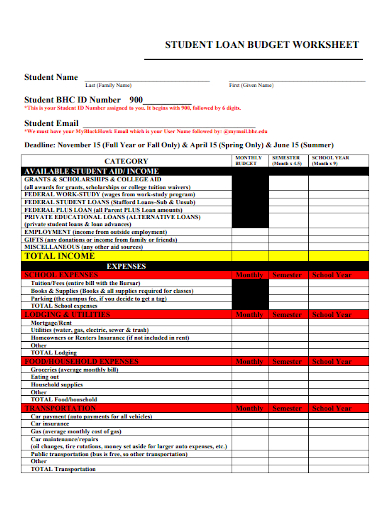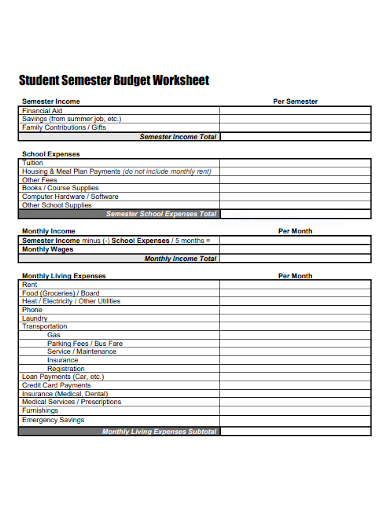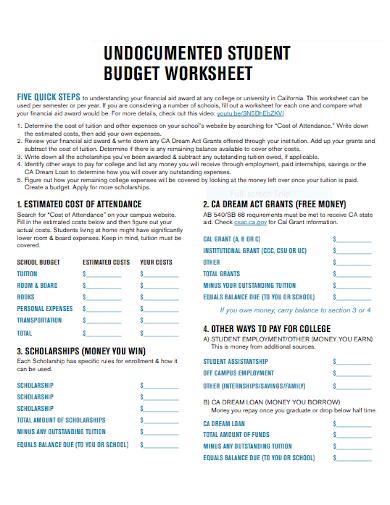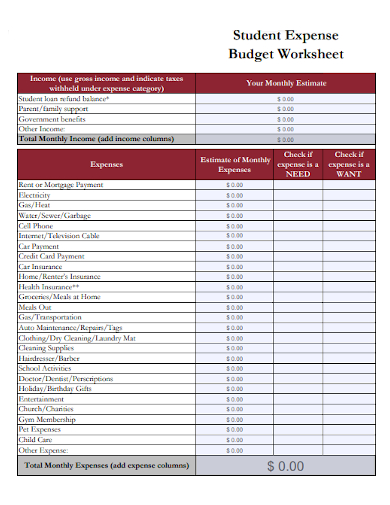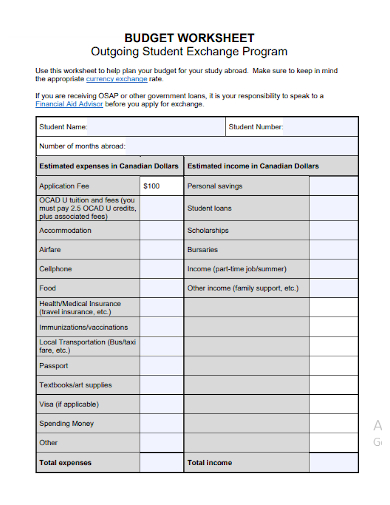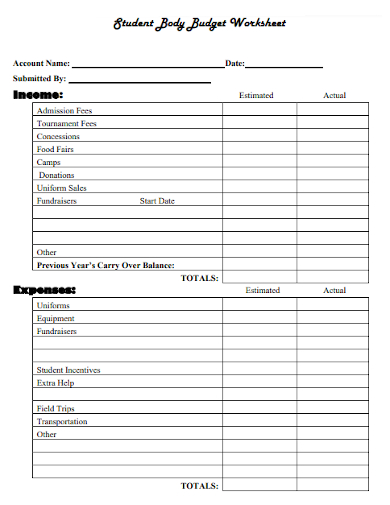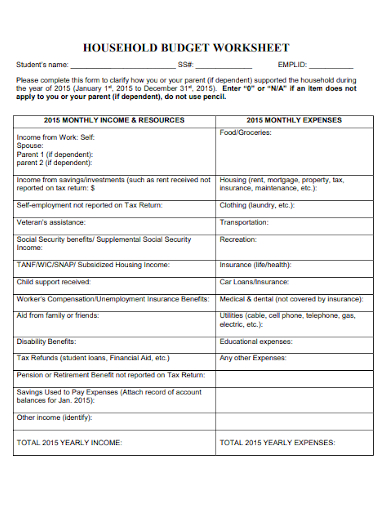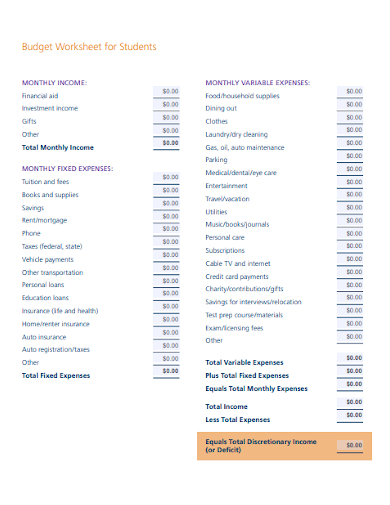Even though you’re still a student, you need to be aware that budgeting is important for your financial stability especially if you’re studying in college or university. This is important not only to equip you on how to do adulting but also to ensure that you can afford to pay for common expenses like rent, tuition, student loans, bills, and entertainment. Budgeting is a useful and proactive approach to organizing your expenses well so you will not squander all your money in useless stuff and all in one instance. The last thing you want to do is to fall into debt which will sink your finances negatively. To help you in budgeting your money, you need a worksheet where you can list down your income and your expenses and add them all up. To help you get started making your own budget worksheet, read the article below.
10+ Student Budget Worksheet Samples
1. Free Student Budget Worksheet Template

2. Free Editable College Student Budget Worksheet
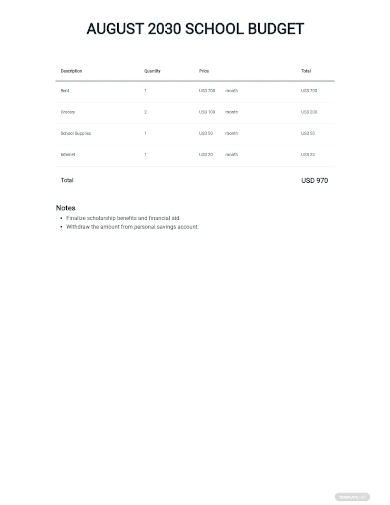
3. College Student Budget Worksheet Template

4. Student Loan Budget Worksheets
5. Student Semester Budget Worksheet
6. Undocumented Student Budget Worksheet
7. Student Expense Budget Worksheet
8. Outgoing Student Exchange Program Budget Worksheet
9. Student Body Budget Worksheet
10. Student Household Budget Worksheet
11. Student Monthly Budget Worksheet
How to Work Out Your Budget
1. Know how much cash you’re going to receive in the coming on a scheduled basis; may it be at the start of the term, or you’ve given a monthly income, etc.
2. List down all the expenses you will have during the period before you receive a new income. Estimate the amount of each expense.
3. Subtract the estimated expenses from your income and divide it by the number of weeks there are during the period before you get another income. This will help you find out how much cash you have to live off week by week.
How to Make A Student Budget Worksheet
Get a sheet of paper or if you prefer to do it electronically, open up a Word document where you can create your budget worksheet. You can also download our free sample templates above to use as your worksheet since the format has already been made. Now it’s time to start writing.
1. List All Income You Will Receive
First, list down the money coming into you. This should be the easy part to write down since it is a much shorter list compared to listing the money going out. Examples of listing the money you might have coming in are:
- Student loans
- Grants, sponsorships, or scholarships
- Cash from parents
- Income from part-time jobs (if you have one)
- Savings you have to spend at school
2. List All the Expenses You Have
The money that you have that will be going out could be more complicated to list everything since some things are what you’re going to spend every day and some expenses only happen periodically. And your expenses will depend on your current conditions as a student. What you’re going to do is to list down all possible expenses you have. Once you have listed them all down, categorize them in a certain category that these expenses are similar to one another. Then, you can list these categories on how often these expenses occur. For example, you can categorize them into daily, weekly, monthly, quarterly spendings and the periodic spendings that you may have such as one-time big purchases or holiday splurges.
Below are some examples of expenses that a student will likely have:
- School expenses: Tuition fees, transportation costs, course supplies such as textbooks, stationery, and other requirements.
- Household bills: Gas, electricity, water, broadband, mobile phone, food, and taxes.
- Miscellaneous: Eating out, entertainment, clothes, haircut, books, subscriptions, large one-off purchases, special occasions (Christmas, birthdays, anniversaries, festivals, holidays)
FAQs
What is a realistic budget for a college student?
The budget of a college student may depend on various factors such as their needs, wants living conditions, the school they attend, and many more. However, the average amount of money a college student spends is around $2,000 per year or about $200 per month. Any budget close to this range is a reasonable budget to provide to a college student.
What is the 50 30 20 budget rule?
The 50/30/20 budget rule is an effective budgeting method that helps an individual manage their money. The way to do this is to divide your monthly income into three categories: 50% for needs, 30% for wants, and 20% for savings or paying off debt.
After listing down your sources of income and all of your expenses and each of their amount, add up first the total income you have, then add up all the total expenses you have. If you think your expenses exceed your income amount, it’s time to let go of some expenses that are not crucial to you. You need to make sure your income is enough or more than enough to pay for all your expenses. Subtract the total income amount and the amount of the total expenses and if you still have remaining money, you can set aside and put it in your savings. Your savings must not be touched by you or anyone since this will serve as your emergency money if crucial events may happen that you need a big amount of money to pay for it. To help you get started writing the worksheet, download our free sample templates above to use as your guide!
Related Posts
FREE 24+ Progress Worksheet Samples in PDF | MS Word
FREE 30+ Development Worksheet Samples in PDF | MS Word
FREE 33+ Course Worksheet Samples in PDF | MS Word
FREE 16+ Verification Worksheet Samples in PDF | MS Word
FREE 14+ Feedback Worksheet Samples in PDF | MS Word
FREE 50+ Assessment Worksheet Samples in PDF | MS Word
FREE 25+ Campaign Worksheet Samples in PDF
FREE 50+ Application Worksheet Samples in PDF | MS Word
FREE 10+ Distribution Worksheet Samples in PDF
FREE 10+ Family Worksheet Samples in PDF
FREE 10+ Personal Worksheet Samples in PDF
FREE 7+ Depreciation Worksheet Samples & Templates in PDF | MS Word
FREE 10+ 4th grade Worksheets Samples in PDF
FREE 10+ Weekly Budget Worksheet Samples in MS Word | MS Excel | Google Docs | Google Sheets | PDF
FREE 10+ Expense Worksheet Samples in PDF

